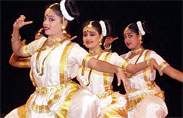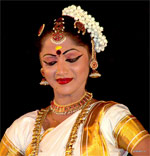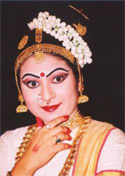MOHINIATTAM
Origin
Mohiniattam dance is mentioned in some eighteenth century texts, but the practical aspect of the style was revived in the reign of Maharaja Swati Tirunal, in 19th century who was the great ruler patron of the arts. Under Swati Tirunal, the dance form of Mohiniattam crystallized as a solo dance tradition with musical compositions set to the Carnatic style of music and a distinct repertoire. Later, in the 20th century, the great poet Vallathol established the Kerala Kalamandalam to promote the arts of Mohiniattam and Kathakali. Here, further research on the work was done and Mohiniattam was codified and revived.Mohiniattam dance form was nurtured in the region of Kerala in southwestern India. Mohiniattam literally means 'Dance of the Enchantress, which has a mesmerizing quality. The white and gold costume, arresting hairstyle with highly graceful movements in medium tempo, contribute to this aesthetic effect. Mohiniattam is usually characterized by swaying movements of the upper body with legs placed in a stance similar to the plie position. In this dance the eyes play an important role in accenting the direction of the movement and showing the emotions.
 Over the past few decades, the repertoire of Mohiniattam has been greatly developed and expanded by dedicated performers who ensured that this beautiful dance style retains a distinct identity among the classical dance form styles of India. Apart from mythology, Mohiniattam consists a range of themes from nature.
Over the past few decades, the repertoire of Mohiniattam has been greatly developed and expanded by dedicated performers who ensured that this beautiful dance style retains a distinct identity among the classical dance form styles of India. Apart from mythology, Mohiniattam consists a range of themes from nature.The Mohiniattam dancers usually wear an off-white colored sari with gold brocade borders. Their hairs are gathered in a bun and decorated with jasmine flowers. The dancer in this dance is adorned with Gold Jewellery including necklaces, bangles, waistbands and anklets. The tinkling of the Jewellery produces music as the dancer performs the dance. The dance is accompanied by musical instruments like violin, Veena and Mridangam and while the dancer narrates episodes from the great epics and legends through elegant steps, rhythmic movements of her arms and amazing facial expressions. The Hastha Lakshandeepika is a classical text which forms the basis of hands and arms movement in Mohiniattam.
Mohiniattam dance form always maintains realistic make-up and simple dressing. The costumes used in dance are very much sober and attractive. The dancer is dressed in a beautiful white and gold-bordered Kasavu saree usually from Kerala. The style of vocal music for Mohiniattam has generally been seen as classical Carnatic. The lyrics are in Manipravala which is a mixture of Sanskrit and Malayalam.
 Earlier, Thoppi Maddalam and Veena provided the background music of Mohiniattam. In recent years these have replaced by the Mridangam and Violin. The performers of Mohiniattam dance usually wear an off-white sari with gold brocade borders. The basic dance steps are the Adavus which are of four kinds: Taganam, Jaganam, Dhaganam and Sammisram. Such names have come out from the nomenclature called Vaittari.
Earlier, Thoppi Maddalam and Veena provided the background music of Mohiniattam. In recent years these have replaced by the Mridangam and Violin. The performers of Mohiniattam dance usually wear an off-white sari with gold brocade borders. The basic dance steps are the Adavus which are of four kinds: Taganam, Jaganam, Dhaganam and Sammisram. Such names have come out from the nomenclature called Vaittari.Steps involved in the dance
Mohiniattam, essentially and usually is solo dance, but these days is being performed in groups as well. The repertoire of Mohiniattam dance closely follows and matches with that of Bharatanatyam. Beginning with Cholkettu, the dancer performs Jathiswaram, Varnam, Padam and Thillana in a concert. Varnam generally combines purity and expression in dance, while Padam tests the histrionic talent of a dancer and Thillana exposes her technical artistry. The basic dance steps are the Adavus which are of four kinds: Taganam, Jaganam, Dhaganam and Sammisram. These names come out from the nomenclature called Vaittari.Popular dancers
 The famous and well known Mohiniattam dancers and teachers are Kalamandalam Satyabhama, Ms. Kanaka Rele, Ms Bharati Shivaji, Chinnammu Amma, Kalyani Kuttiamma, Sunanada Nair, Deepti Nair, Pallavi Krishnan and so on. Mohini Attam is just beginning to be accepted outside of Kerala. One is starting to find it used at towards the end of Bharat Natyam perfomances. Therefore, one is starting to find instruments that are normally associated with Bharat Natyam (e.g., mridangam, veena, etc). However more traditional forms of Mohiniattam dance use instruments such as shuddha madalam and edakka (uddaku).
The famous and well known Mohiniattam dancers and teachers are Kalamandalam Satyabhama, Ms. Kanaka Rele, Ms Bharati Shivaji, Chinnammu Amma, Kalyani Kuttiamma, Sunanada Nair, Deepti Nair, Pallavi Krishnan and so on. Mohini Attam is just beginning to be accepted outside of Kerala. One is starting to find it used at towards the end of Bharat Natyam perfomances. Therefore, one is starting to find instruments that are normally associated with Bharat Natyam (e.g., mridangam, veena, etc). However more traditional forms of Mohiniattam dance use instruments such as shuddha madalam and edakka (uddaku). Over the years the repertoire of Mohiniattam dance form in India has been developed and expanded by dedicated performers who have ensured that this beautiful dance style retains a distinct identity among the classical dance styles of India. Apart from mythology and great epics Mohiniattam contains a range of themes from nature.
Learning Mohiniattam
Director Sagreen InternationalTC 66/655(7) Poonkulam, Vellayani-PO
Thiruvananthapuram-695522 Kerala, INDIA
Phone : + 91 9287249906 , +91 9349422304
email : [email protected]
Bharati Shivaji
104, Bhaktawar Singh Block, Asian Games Village
New Delhi 110 048
Tel: (011) 26492578
Email: [email protected] Website: www.bharatishivaji.com
Mysore Kala Kendra,
Vani Villas Mohalla
# 286/3, 6th Main, Vani Villas Mohalla, Mysore - 570002.
Ph.no 821-4246101.
Vijnana Kala Vedi Cultural Centre, Kerala
Contact No. : 4682214483
Email : [email protected]
Website : www.vijnanakalavedi.org


